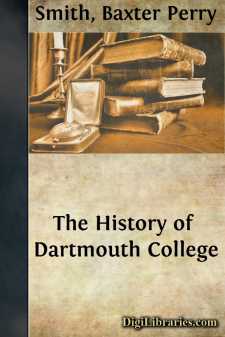Categories
- Antiques & Collectibles 13
- Architecture 36
- Art 48
- Bibles 22
- Biography & Autobiography 813
- Body, Mind & Spirit 142
- Business & Economics 28
- Children's Books 15
- Children's Fiction 12
- Computers 4
- Cooking 94
- Crafts & Hobbies 4
- Drama 346
- Education 46
- Family & Relationships 57
- Fiction 11828
- Games 19
- Gardening 17
- Health & Fitness 34
- History 1377
- House & Home 1
- Humor 147
- Juvenile Fiction 1873
- Juvenile Nonfiction 202
- Language Arts & Disciplines 88
- Law 16
- Literary Collections 686
- Literary Criticism 179
- Mathematics 13
- Medical 41
- Music 40
- Nature 179
- Non-Classifiable 1768
- Performing Arts 7
- Periodicals 1453
- Philosophy 64
- Photography 2
- Poetry 896
- Political Science 203
- Psychology 42
- Reference 154
- Religion 513
- Science 126
- Self-Help 84
- Social Science 81
- Sports & Recreation 34
- Study Aids 3
- Technology & Engineering 59
- Transportation 23
- Travel 463
- True Crime 29
The History of Dartmouth College
Description:
Excerpt
INTRODUCTION.
The most valuable part of a nation's history portrays its institutions of learning and religion.
The alumni of a college which has moulded the intellectual and moral character of not a few of the illustrious living, or the more illustrious dead,—the oldest college in the valley of the Connecticut, and the only college in an ancient and honored State,—would neglect a most fitting and beautiful service, should they suffer the cycles of a century to pass, without gathering in some modest urn the ashes of its revered founders, or writing on some modest tablet the names of its most distinguished sons.
The germ of Dartmouth College was a deep-seated and long-cherished desire, of the foremost of its founders, to elevate the Indian race in America.
The Christian fathers of New England were not unmindful of the claims of the Aborigines. The well-directed, patient, and successful labors of the Eliots, Cotton, and the Mayhews, and the scarcely less valuable labors of Treat and others, fill a bright page in the religious history of the seventeenth century. To numerous congregations of red men the gospel was preached; many were converted; churches were gathered, and the whole Bible—the first printed in America—was given them in their own language.
This interest in the Indian was not confined to our own country, in the earlier periods of our history. In Great Britain, sovereigns, ecclesiastics, and philosophers recognized the obligations providentially imposed upon them, to aid in giving a Christian civilization to their swarthy brethren, who were sitting in the thickest darkness of heathenism in the primeval forests of the New World. Societies, as well as individuals, manifested a deep and practical interest in the work.
We can only touch upon some of the more salient points of this subject. But it is especially worthy of note, that the elevation of the Indian race, by the education of its youth, was not an idea of New England, nor indeed of American, birth.
In Stith's "History of Virginia" (p. 162), we find in substance the following statements: At an early period in the history of this State, attempts were made to establish an institution of learning of a high order. In 1619, the treasurer of the Virginia Company, Sir Edwin Sandys, received from an unknown hand five hundred pounds, to be applied by the Company to the education of a certain number of Indian youths in the English language and in the Christian religion. Other sums of money were also procured, and there was a prospect of being able to raise four or five thousand pounds, for the endowment of a college. The king favored the design, and recommended to the bishops to have collections made in their dioceses, and some fifteen hundred pounds were gathered on this recommendation. The college was designed for the instruction of English, as well as Indian, youths. The Company appropriated ten thousand acres of land to this purpose, at Henrico, on James River, a little below the present site of Richmond....


